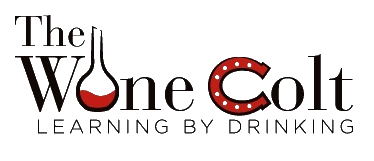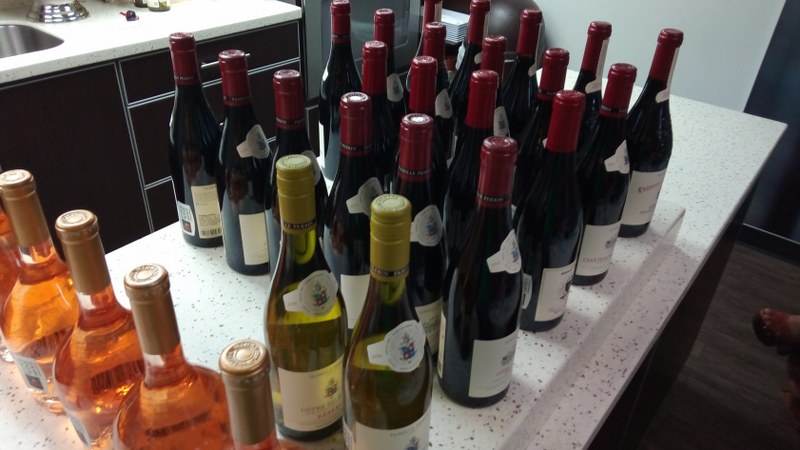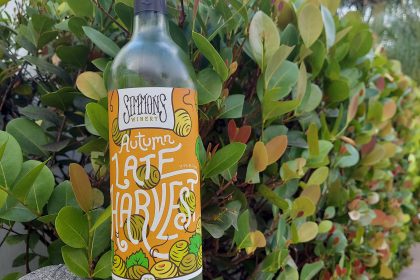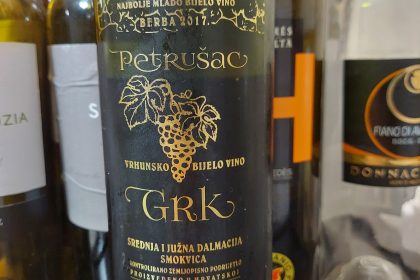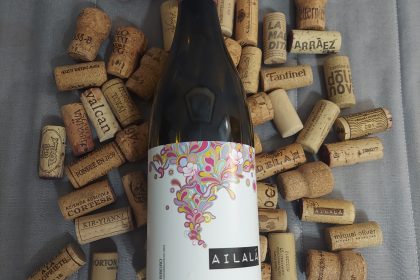One of the great things for those who enjoy wine nuances is that every year you have something new to explore because not two vintages are exactly the same. So experiences to listen and discuss with brand ambassadors are an essential part for the curious aficionado. In Puerto Rico we are never short of such presentations and one of the places that tries to keep a steady roster of lecturers is The House. Here’s where I met Michael Jordan (MS,CWE) last year and a few weeks back I had the opportunity to listen to Emmanuel Lemoine, US Director of Exports for Famille Perrin.
During his presentation we would try six wines from Rosé to Pape and hear nuggets of information regarding each individual winery under the Perrin umbrella. The crew of The House was very courteous and helpful while we settled in.
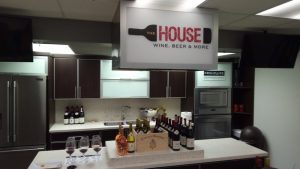
We started the evening with a semi famous brand and perhaps not for the best reasons. Miraval Rose Cotes de Provence 2016. You know this wine as the Brangelina wine. On the one hand, that must have helped in sales which will always be welcome by brand owners, but then again, the wine falls to second place behind the celebrities and for someone who enjoys wine more than celebrities…that’s a shame. Anyway, while we gave the wine a test drive we saw pictures and learned about the lavender fields all around the vineyard and how in 1979, before Famille Perrin owned it, Pink Floyd recorded The Wall album there thank you very much. It is surrounded by old roads that go back to roman times which I found impressive. Unfortunately the estate is not open to the public for visits so the pictures will have to do.
Regarding the drinkability of the wine, well it has 13% of alcohol, fruity and refreshing but it is not, nor do I think is meant to, be a wine to age. I’ve never paid too much attention to color of wine but the pale pink on this wine was charming. Crisp and a short finish this wine for me, coming from the tropics, screams summer outing.
The second wine we tried was their Cotes Du Rhone Reserve White 2016 which is a blend of voignier and white grenache. This wine was very mineral on first contact. It was crisp with some acidity and in my opinion medium body and yellow fruits flavors. It was around this time we were told that Famille Perrin has always been organic and never used chemicals in their vineyards and that’s why they say organic since the 1950’s .
The third wine had a fantastic nose right from the start. It was the Cotes Du Rhone Village 2013. This wine is a blend of 55% gernache, 40% syrah and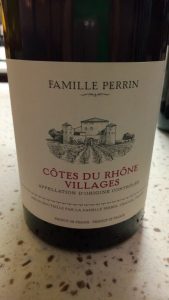 5% mourvedre. The wine is actually aged in burgundy barrels to soften the end result of the young vines. It had a pinkish purple color and a light opacity. In my first attempt actually trying it I was a little unmoved by the results but that’s why you don’t drink the whole glass right away. As it opened a bit, the nose remained fantastically jammy and red fruit forward but the mouth got better. Also the price was fantastic so of course I took a bottle home.
5% mourvedre. The wine is actually aged in burgundy barrels to soften the end result of the young vines. It had a pinkish purple color and a light opacity. In my first attempt actually trying it I was a little unmoved by the results but that’s why you don’t drink the whole glass right away. As it opened a bit, the nose remained fantastically jammy and red fruit forward but the mouth got better. Also the price was fantastic so of course I took a bottle home.
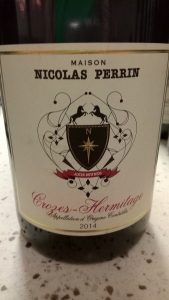 This next wine for me was WOTN (Wine of the Night). Unfortunately it ran out before I could buy a bottle but I’ll be back. It was the Perrin Crozes-Hermitage 2015. 100% Syrah. Great garnet color, deep peppery nose, with smokey hints. They use concrete vats at first and then they move to the aging process using old burgundy wooden vats. A sign this wine was something I enjoy is my “look at my glasses and see which one is closest to empty” approach. Emmanuel shared with us that the fermage is a key part of these vineyards since it’s pretty difficult to own them so it forces them to make the best wine they can each year. There was nothing I didn’t like about this wine and it was good now, but in a couple of years probably even better. The wine has 13% of alcohol even though 2015 didn’t receive the praise previous years have received, that doesn’t take anything away from it.
This next wine for me was WOTN (Wine of the Night). Unfortunately it ran out before I could buy a bottle but I’ll be back. It was the Perrin Crozes-Hermitage 2015. 100% Syrah. Great garnet color, deep peppery nose, with smokey hints. They use concrete vats at first and then they move to the aging process using old burgundy wooden vats. A sign this wine was something I enjoy is my “look at my glasses and see which one is closest to empty” approach. Emmanuel shared with us that the fermage is a key part of these vineyards since it’s pretty difficult to own them so it forces them to make the best wine they can each year. There was nothing I didn’t like about this wine and it was good now, but in a couple of years probably even better. The wine has 13% of alcohol even though 2015 didn’t receive the praise previous years have received, that doesn’t take anything away from it.
It was time to reach the Chateauneuf Du Pape’s. First we tried Les Sinards 2014 which they call Baby Beaucastel. We were explained how they decide to make the two wines. It seems that young vines, those under fifteen years of age go to Les Sinards. The older ones go to the top CDP. Emmanuel mentioned how the soil is mainly limestone where the vines for the wine are and at that point someone asked him why separate vines at 16. He joked about how we are at 16 years of age and how we are when we get older. So he didn’t really explain the particular reason of that precise cutoff point but in a way, I guess he doesn’t have to tell us everything. Maybe it was just a nominal decision. I don’t recall the context but he did mention right before going to the last wine about how we don’t want a big berry but one with the right amount of water because big berries are for eating not wine making. Makes sense, but the reason he made the comment escapes me. The wine was great and got 91 points by WS. Deep colors with high opacity and a plush aroma mainly of black fruits and hints of spices that I guess are courtesy of the Syrah in it. I would definitely would not drink this right now and would store it but I guess that’s a personal choice. It will become a greater wine in a few years.
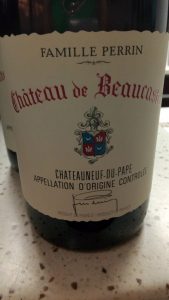 Finally we got to the big guy. Chateauneuf Du Pape Beaucastel 2014. The estate gets its name from noble Pierre de Beaucastel who in 1549 bought some land and started growing some wine. However it wasn’t until 1903 when professor of engineering Pierre Perrin took control of the property that it started blossoming into what it would later become: one of the finest producers of CDP. Five generations of Perrin have run through this farm and till this day run it as a family. This particular vintage is the culmination of a blend between 16 grapes (you read that right) out of the maximum of 18 which Chateauneuf allows (used to be only 13 grapes until 2009 when the AOC rules changed). This particular wine is mainly mourvedre and it has a 5% of white wine which softens the edges and the color. They basically make 50 different wines, declassify some of them and the rest are made into blend. It is aged 12 months unfiltered. This wine was a RP 94 pointer. Very opaque almost obscure color with as expected black berries on nose, but a bit floral as well. The nose is present but not overwhelming and even though its a young wine, it wasn’t bitter-full of tannins. It felt mature, full body and easy to drink now which is not something I tend to say about CDP (Even after a decade I sometimes have a hard time saying they are ready). But this one was different. Maybe that 5% white wine? The question for me is, how does a wine blend of 16 grapes age? Because I don’t have that answer.
Finally we got to the big guy. Chateauneuf Du Pape Beaucastel 2014. The estate gets its name from noble Pierre de Beaucastel who in 1549 bought some land and started growing some wine. However it wasn’t until 1903 when professor of engineering Pierre Perrin took control of the property that it started blossoming into what it would later become: one of the finest producers of CDP. Five generations of Perrin have run through this farm and till this day run it as a family. This particular vintage is the culmination of a blend between 16 grapes (you read that right) out of the maximum of 18 which Chateauneuf allows (used to be only 13 grapes until 2009 when the AOC rules changed). This particular wine is mainly mourvedre and it has a 5% of white wine which softens the edges and the color. They basically make 50 different wines, declassify some of them and the rest are made into blend. It is aged 12 months unfiltered. This wine was a RP 94 pointer. Very opaque almost obscure color with as expected black berries on nose, but a bit floral as well. The nose is present but not overwhelming and even though its a young wine, it wasn’t bitter-full of tannins. It felt mature, full body and easy to drink now which is not something I tend to say about CDP (Even after a decade I sometimes have a hard time saying they are ready). But this one was different. Maybe that 5% white wine? The question for me is, how does a wine blend of 16 grapes age? Because I don’t have that answer.
Famille Perrin has it’s wines separated and even their websites for example, Miraval has it’s own site, then under Famille Perrin they have Les Crus which is where you find information about the Cotes Du Rhone and Les Sinards. There’s Les Alexandrins where they have details about the Crozes-Hermitage and finally Beaucastel for their renowned Chateauneuf Du Pape. They have quite an extensive variety of wines but these are the ones that currently Fine Wine Imports is presenting in Puerto Rico.
Overall, it was a very nice evening that did not end after the vertical was completed. But I’ll continue that story in another blog post. Not because I like suspense but because it included other wines, another distributor and another group of conversations that are better served separately.
